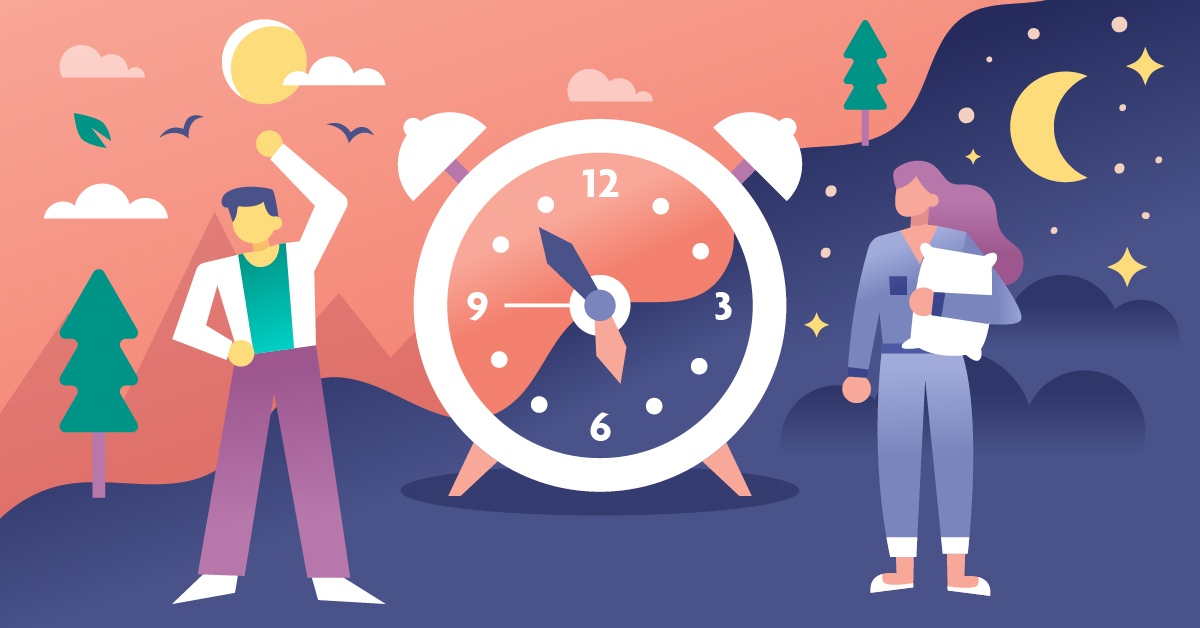Did you know your body has a clock? Called the circadian rhythm, your body’s clock helps regulate activity both inside and outside of your body. Guided by the release of hormones, your body’s clock creates patterns that typically follow a 24-hour cycle. Some of these patterns include:
- Alternating periods of wakefulness and sleep
- Hunger cues, or just the drive to eat, four to six times a day
- Fluctuating body temperature according to how active your body thinks you need to be
If you get out of sync with your body’s clock, a whole host of symptoms commonly crop up, including trouble falling or staying asleep, fatigue, brain fog, poor memory, mood swings, and physical issues such as headaches or stomach trouble. Not everyone has the same circadian rhythm pattern, which can make it easy to get out of sync with yours.
Learn Your Circadian Rhythm Chronotype
Biologically, there are four chronotypes, each of which has different requirements for staying as healthy as possible. Your circadian rhythm is primarily controlled by exposure to light, and knowing how yours works is one of the keys to feeling your best.
The four circadian rhythm chronotypes, or “time-types,” are Bears, Wolves, Lions, and Dolphins. Each of these animals has a different rhythm to their daily lives, and so do you. To figure out which chronotype you belong to, think about how you function when you feel your best and ask yourself these questions:
- When you don’t have to set an alarm, when do you wake up?
- When you have nowhere to be in the morning, when do you prefer to go to bed?
- When are you most energetic during the day? When are you most productive or creative?
The answers to these questions could be as specific as an exact time (7 a.m., 10 p.m.) or as vague as “really early” or “in the afternoon.”

There’s a chart that lists chronotypes. Make note of the row that seems to fit your core pattern most appropriately. By core, we mean the pattern that is the least influenced by an alarm clock, a schedule, caffeine, and sleep meds.
Do You Need to Resync Your Circadian Rhythm?
Once you’ve figured out your chronotype, it’s time to discuss getting back in sync with your circadian rhythm. If you’re one of the lucky few, your body’s preferences match your daily schedule. For most of us, though, our circadian rhythm can work against us, causing energy dips, irritability, and other negative effects.
A few of the common factors that throw your body’s clock out of sync generally revolve around sleep hygiene, or the habits surrounding your sleep that improve sleep quality. For example, if you use artificial lights or electronics close to bedtime, your circadian rhythm may get confused about what time of day it is. If you work second or third shift or have a rotating schedule, your sleep and wake times likely fluctuate, throwing things out of whack.
Ways to resync your circadian rhythm are straightforward.
- Stick to a regular sleep schedule. Don’t confuse your body by sleeping in some days and getting up far earlier on others.
- Avoid electronics an hour before bed. If you can’t do that, get a blue light filter to minimize their impact.
- Sleep in a cool, dark room with as little light as possible. If you struggle to decrease ambient lighting, a sleep mask may work well for you.
- As soon as you can in the morning, step outside into the sunlight or use a sunlight therapy lamp. A lot of people find their mood improves by adopting this habit!
- Try not to eat close to bedtime.
- Rest when you feel your body needs to rest instead of relying on stimulants, such as caffeine, to power through. While this isn’t always possible, it’s worth trying.
Adopting these healthy sleep habits at once can be overwhelming, but make a few gradual shifts and your body will be in sync with your natural rhythms in no time.
